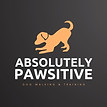
ABSOLUTELY PAWSITIVE
RESOURCES & TIPS
IDENTIFYING NERVOUS BEHAVIOUR
WHAT TO CONSIDER WHEN SHARING YOUR HOUSE WITH A DOG
Many of the dogs that come into our care have had extremely poor starts to their lives which may lead to them displaying nervous behaviours.
It is important that you know when your new best friend is feeling anxious. Most people will be familiar with the obvious signs, but there are many subtle signs which you can look out for and identify
before your dog’s anxiety progresses further.
Subtle signs of nervous / anxious behaviours:
● Looking away from the subject that is causing anxiety
● Lip licking
● Yawning (when not tired)
● Panting (when not hot or thirsty)
● Avoiding the situation (moving away, possibly trying to hide)
● Pinning back the ears
If any of these behaviours are detected then move your dog out of the situation, or try to distract your dog with something fun and positive such as his/her favourite toy.
If the subtle signs of nervous behaviour go unnoticed or are ignored then these will develop into more obvious behavioural signs.
Obvious signs of nervous / anxious behaviours:
● Cowering and lowered body position
● Tail tucked between the legs or a low tail wag
● Whites of eyes showing
● Freezing (stops as though frozen to the spot)
● Lip curling (the front part of the lip curls up)
If any of these behaviours are displayed, the dog should be removed from the situation immediately.
Dogs can be a wonderful addition to any home. But it is important to remember that if you are in charge of a dog, you are responsible for how it behaves, not only in public, but also at home. Take steps to make sure interactions with other dogs and people, particularly children, are safe.
-
If dogs are treated well as puppies, they learn to see people as friends. Learning to get on with people, dogs and other animals is an essential part of social development for a puppy.
-
Dogs are sociable animals that need, and enjoy, company. So most dogs do not like being left alone and may suffer if left without company, or with nothing to do for long periods of time.
-
Normal child activity - running, shouting and high-energy play - can be overwhelming for dogs. So it’s really important children learn to be considerate of their four-legged friends and know how to safely spend time with them.
Be consistent and fair with rules
Being inconsistent with rules is one of the easiest ways to confuse and frustrate your dog.
Let's say you tossed him a treat at the table during dinner?
By doing that you encouraged more begging, even if it was unintentional on your part.
Remember to be consistent when you set rules and boundaries for your dog. Don’t let them get away with something one day only to punish them for it the next. Having clear rules and boundaries will ensure your dog knows exactly what’s expected of them at any given time, and it will help avoid the frustration of inconsistent punishment.
And make sure everyone in the family sticks to that rule.

